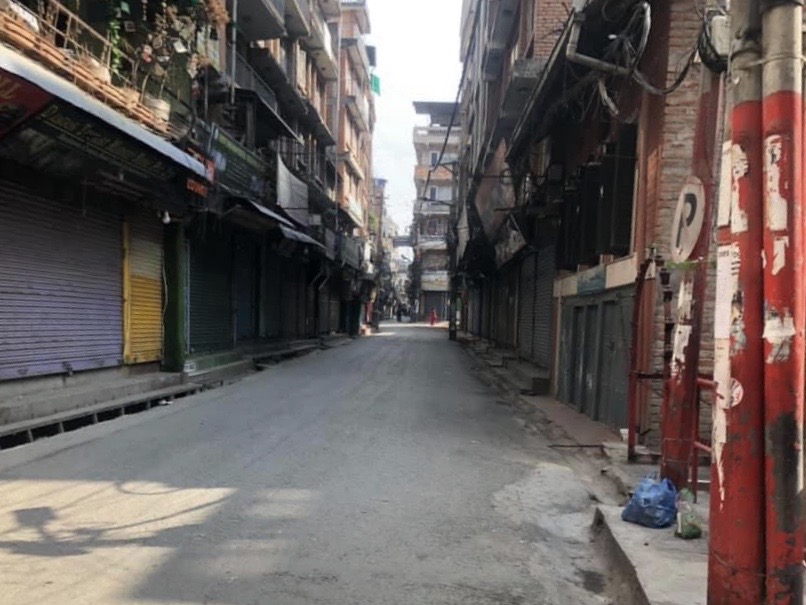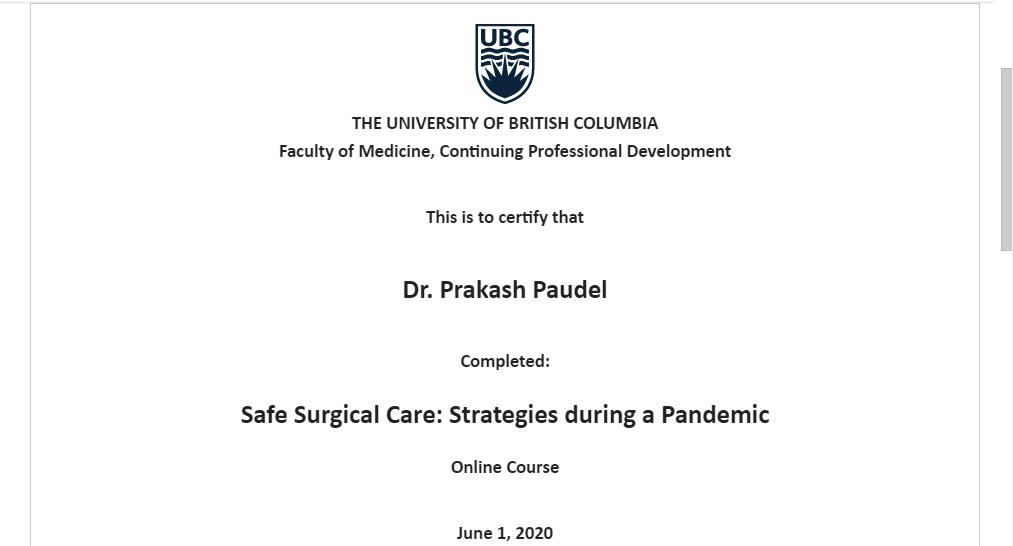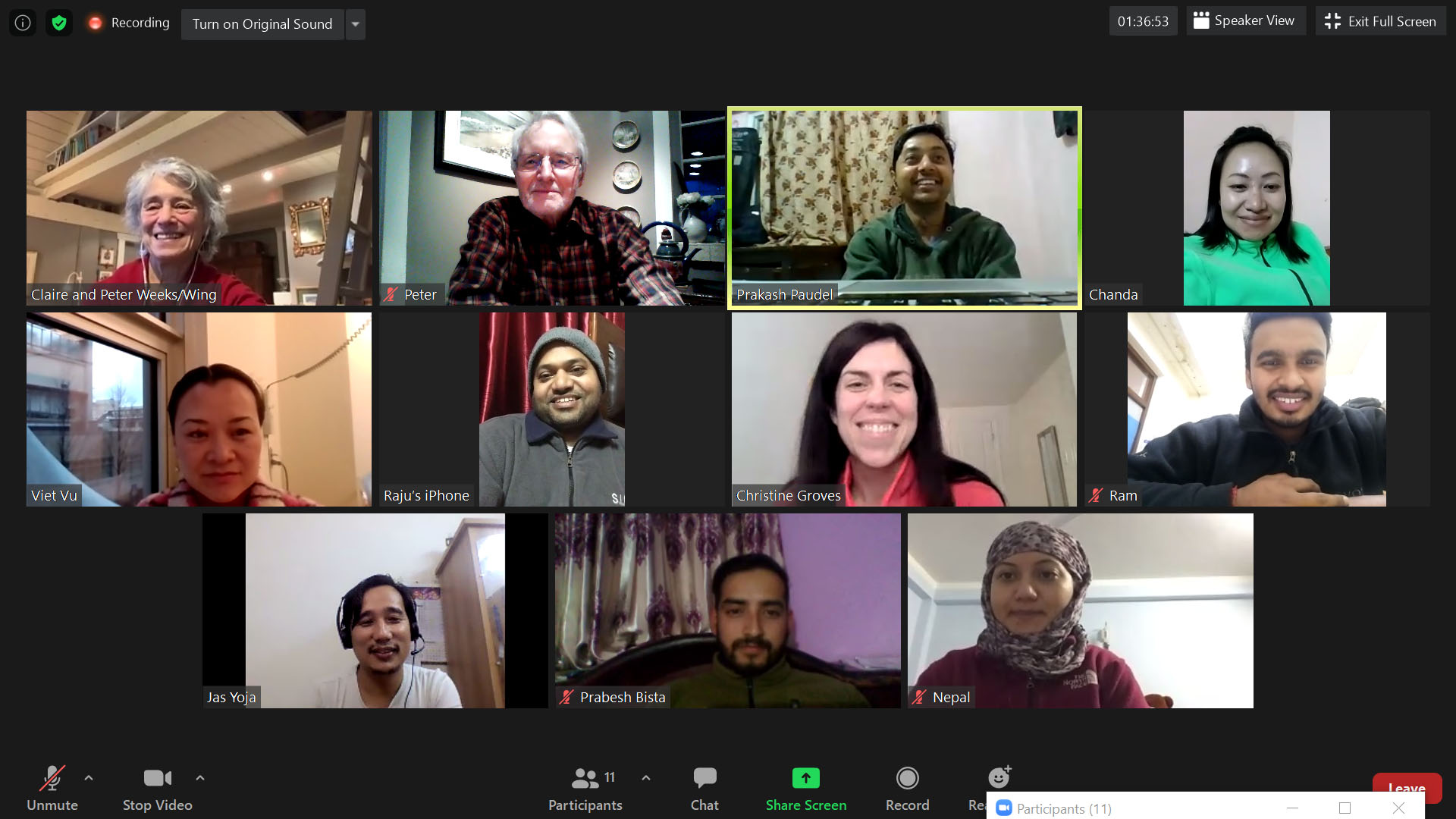2020
March 29 2020 – COVID-19 in Nepal
The COVID-19 pandemic had now swept around the world; its toll reflected in the daily numbers. Visiting friends in Florida in early March, we headed home as the pandemic declaration by WHO was announced.
A WHO situation report noted five known COVID cases in Nepal. Borders were ‘closed’. However, a group of returning Nepalis coming back from India, detained for a while in a poorly fenced facility, decided to leave by hopping over a fence, making a poor start to the campaign against the virus. School closures were felt to account for the decision of many people to head for their ‘home’ villages over several days. As many as 130,000 people were going daily, especially school and college students, for their home towns.
May 19 2020 
The photo (right) taken by our friend Himalayan guide Agasta Mukhiya in the last few days in the formerly bustling tourist centre of Thamel showed stores boarded shut and empty streets. Raju was working from home, going in to the hospital as needed. Three house doctors covered most patient needs on a week-at-a-time rotation, as did the multidisciplinary teams. Jas prepared to return to Nepal to face two weeks of mandatory quarantine and to possibly train and work alongside Dr Raju once flights and airports are available.
Jun 2 2020 
Prakash took a UBC online course addressing the special consideration needed when considering surgery during the pandemic (certificate right), following, a webinar chaired by VGH’s Dr Brian Kwon, addressing current concepts of Degenerative Cervical Myelopathy (DCM), which he found very valuable.
Jun 24 2020
Jas received written confirmation that he could progress to final year. His research project was to be an assessment of quality of life in patients with Ankylosing Spondylitis, piloting a Bangla version of the SF-36 health survey instrument to the mental and physical aspect of quality of life.
Aug 21 2020
Dr Raju was self-isolating in quarantine in the spare bedroom of their house, working from home. Jas, wearing PPE, was sleeping in the doctor’s call room at SIRC. Raju’s wife and child were in the house; his mother-in-law, working in a children’s home, stayed at work for this time. Jas was at SIRC for two weeks, after a nerve-wracking trip down from Pokhara. The way had been cleared through mud slides across the road, boulders hanging in the air and waiting to fall on the roadway. Clearly, both Raju and Jas were happy that Jas was able to work at SIRC because other doctors were isolated at the moment. Staff members’ families were anxious about their loved ones going to work. In many ways, the situation paralleled what we in Vancouver were seeing in our extended care homes.
Sept 3 2020
The total SIRC population at the beginning of the outbreak was 242 including patients (53), staff (102), caregivers (69), vocational trainees and family (18) and includes some staff at home. As of the date of testing there were 104 total positives, 134 negative (238 total tests; a few went home). The number remaining at SIRC was 165, triaged to separate areas in the hospital. SpiNepal has committed to assisting with the enhanced costs of care.These images courtesy of SIRC provided a sense of the measures being taken. This week the International Spinal Cord Society held its first virtual annual meeting which Prakash, Raju, and four others from SIRC attended.
Sept 17 2020
Very early Zoom meetings linked us with colleagues in Nepal, Australia, Belgium, the UK, the US and on both Canadian coasts, including Esha Thapa (the executive director of SISN, the NGO in Kathmandu that operates SIRC and its affiliated vocational training program), Board chair Prachanda Bahadur Shrestha and member Dr. Anil Shrestha, as well as SIRC’s administrative director Hari Adhikari and senior medical director Raju Dhakal. Drs Colleen O’Connell and Christine Groves, ISCoS board members Prof James Middleton and Stephen Muldoon, and Humanity and Inclusion’s emergency and rehabilitation response specialist Eric Weerts also joined the group. We learned that 106 people in the SIRC facility still tested positive with economic challenges facing SIRC due to the drop in normally revenue producing activities. Although a large number of people had positive COVID tests, very few were experiencing symptoms, to our knowledge.
November 27 2020
Nepal was averaging 1,768 new COVID infections daily, 46% of the peak on October 21, totalling 229,343 infections and 1,435 coronavirus-related deaths reported in the country since the pandemic began. SIRC has not had further outbreaks.
The COVID-19 pandemic had serious effects on the tourist-based economy. Quoting from the Nepali Times on this date: For the thousands of porters, kitchen staff, yak and pony caravan owners, and traders it has been an unimaginable disaster. Lukla airfield, which used to get 60 flights a day, was closed after the last trekkers flew out in March. It only reopened in early October, and foreign trekkers and mountaineers were allowed back from 17 October. The Sagarmatha National Park got more than 60,000 visitors in 2019 – nearly ten times the local population of the region. So far this year, it has got only 4,000, and most of those after October has been Nepali tourists. The National Park’s income has been sharply reduced, affecting its conservation work. Sherpas who usually travel to the other parts of the world for work as mountain guides and other jobs have not been able to go this year. Sixty households in Khunde, for instance, have members that used to travel to Norway every summer to work on hiking trails there. The families have been deprived of that income.
SIRC’s participation in telerehabilitation served them well, making it possible to support rehab care remotely in a very cost-effective manner.
December 21 2020
As happened in the US, the unstable administration in Nepal, sadly, moved the pandemic away from being the major news item. Washington Post on this date: “Nepalese President Bidhya Devi Bhandari dissolved the country’s parliament Sunday at the request of the prime minister, who is in the midst of an intraparty feud destabilizing the country. Prime Minister KP Sharma Oli asked for the legislative body to be dissolved so he wouldn’t have to step down in favor of a rival according to the political agreement that formed the current government in 2017, bringing the country to the brink of a constitutional crisis. Two communist parties merged with the understanding that the leaders would trade places as prime minister after 2 1/2 years. Oli, however, has been reluctant to step aside, leading to a rift in the party. …..Fresh parliamentary elections will be held in two phases on April 30 and May 10 — a year early — according to the president’s office. It is not clear if the two parties making up the ruling coalition will separate ahead of the contest.” There was no functioning public health leadership and COVID-19 precautions were being left to the individual.
Raju and a number of his staff attended online the annual Indian Spine and Spinal Cord Injuries Conference, from New Delhi Dec 9-13.
 With Dr Jas preparing for his final exams, we worked with Canadian colleagues in New Brunswick and Vancouver and Dr Christine Groves in Indiana to conduct a series of Zoom seminars focusing primarily on SCI-related topics. Jas was with us from Dhaka, Prakash and Raju from Kathmandu, joined by Vancouver’s Dr Joanna Mereu and some of the SIRC medical and rehabilitation staff. Claire reviewed the history of SCI care; on Dec 17th (screenshot shown) Peter reviewed the healing process of spine fractures as relates to the choice and expectations of conservative and surgical care for the new injury. Drs Andrea Townson and Viet Vu also supported this work.
With Dr Jas preparing for his final exams, we worked with Canadian colleagues in New Brunswick and Vancouver and Dr Christine Groves in Indiana to conduct a series of Zoom seminars focusing primarily on SCI-related topics. Jas was with us from Dhaka, Prakash and Raju from Kathmandu, joined by Vancouver’s Dr Joanna Mereu and some of the SIRC medical and rehabilitation staff. Claire reviewed the history of SCI care; on Dec 17th (screenshot shown) Peter reviewed the healing process of spine fractures as relates to the choice and expectations of conservative and surgical care for the new injury. Drs Andrea Townson and Viet Vu also supported this work.